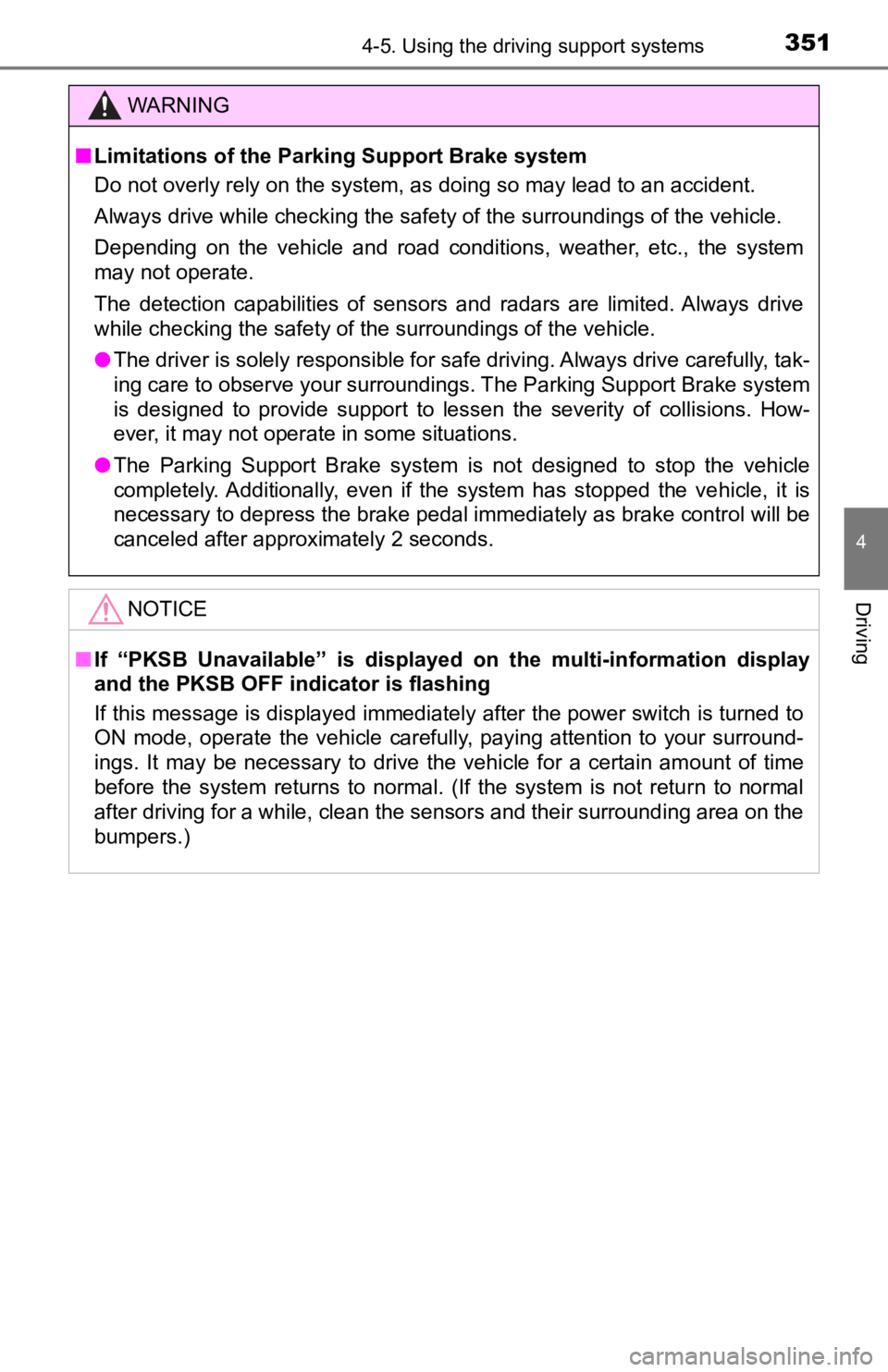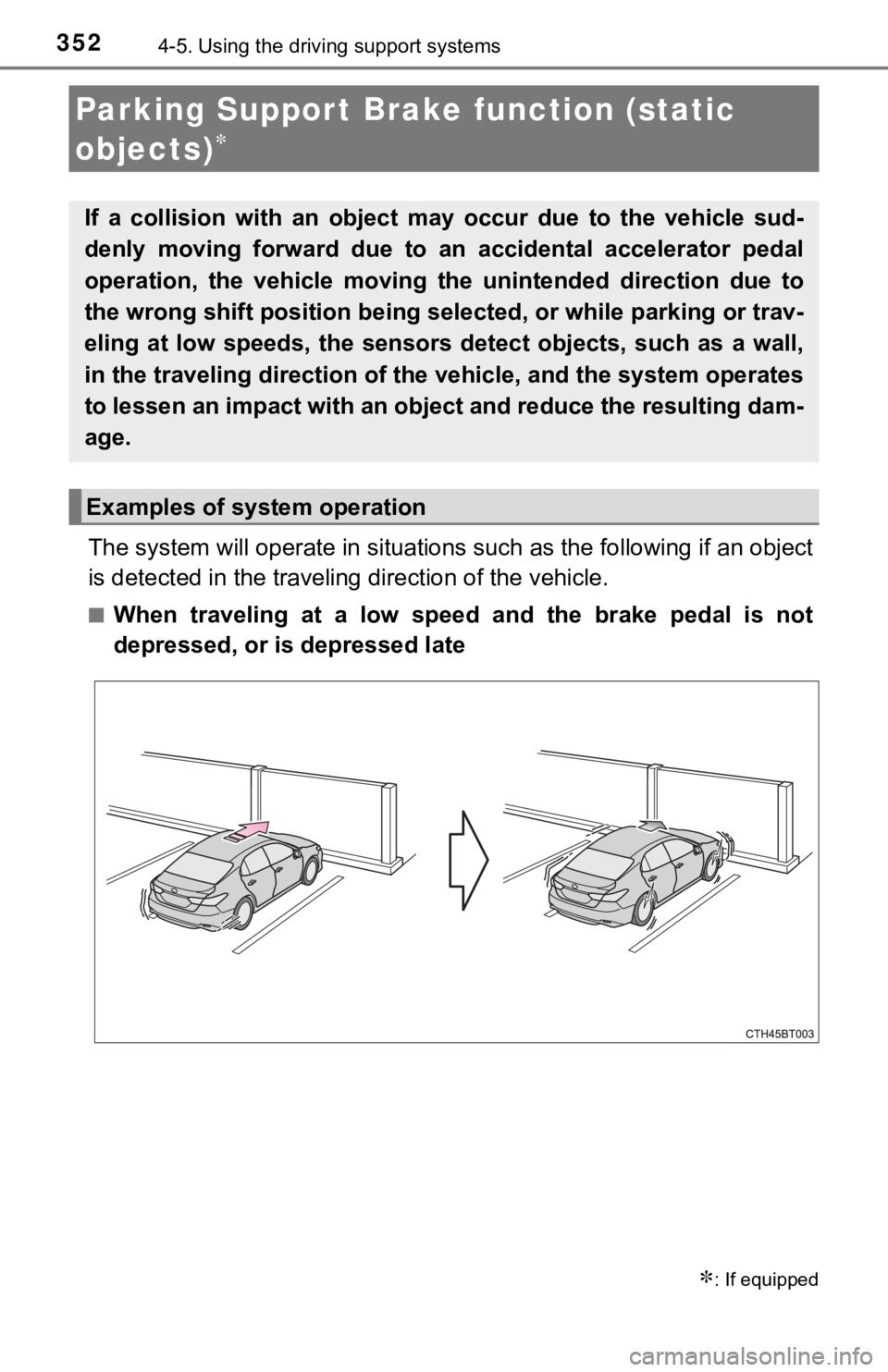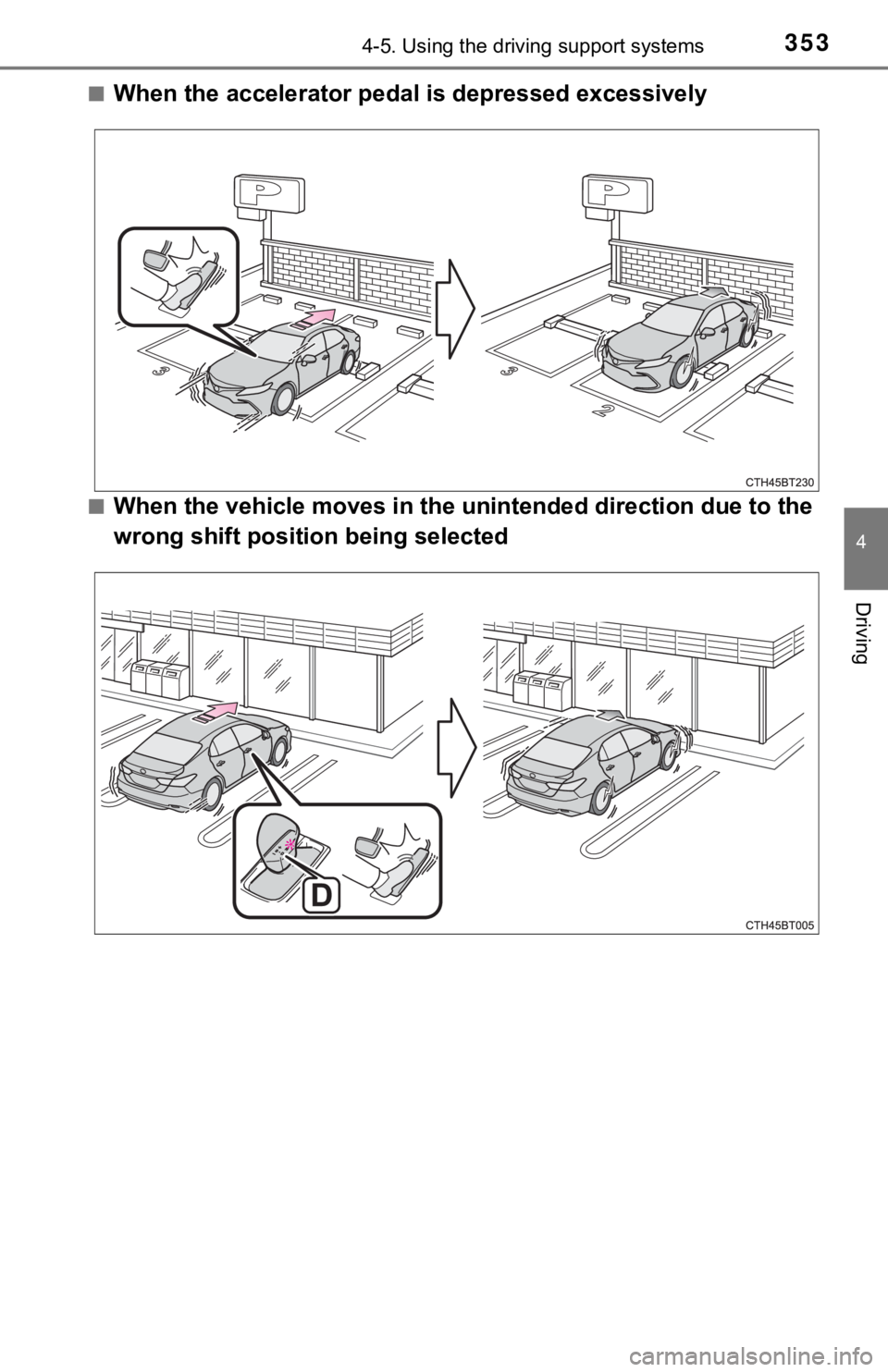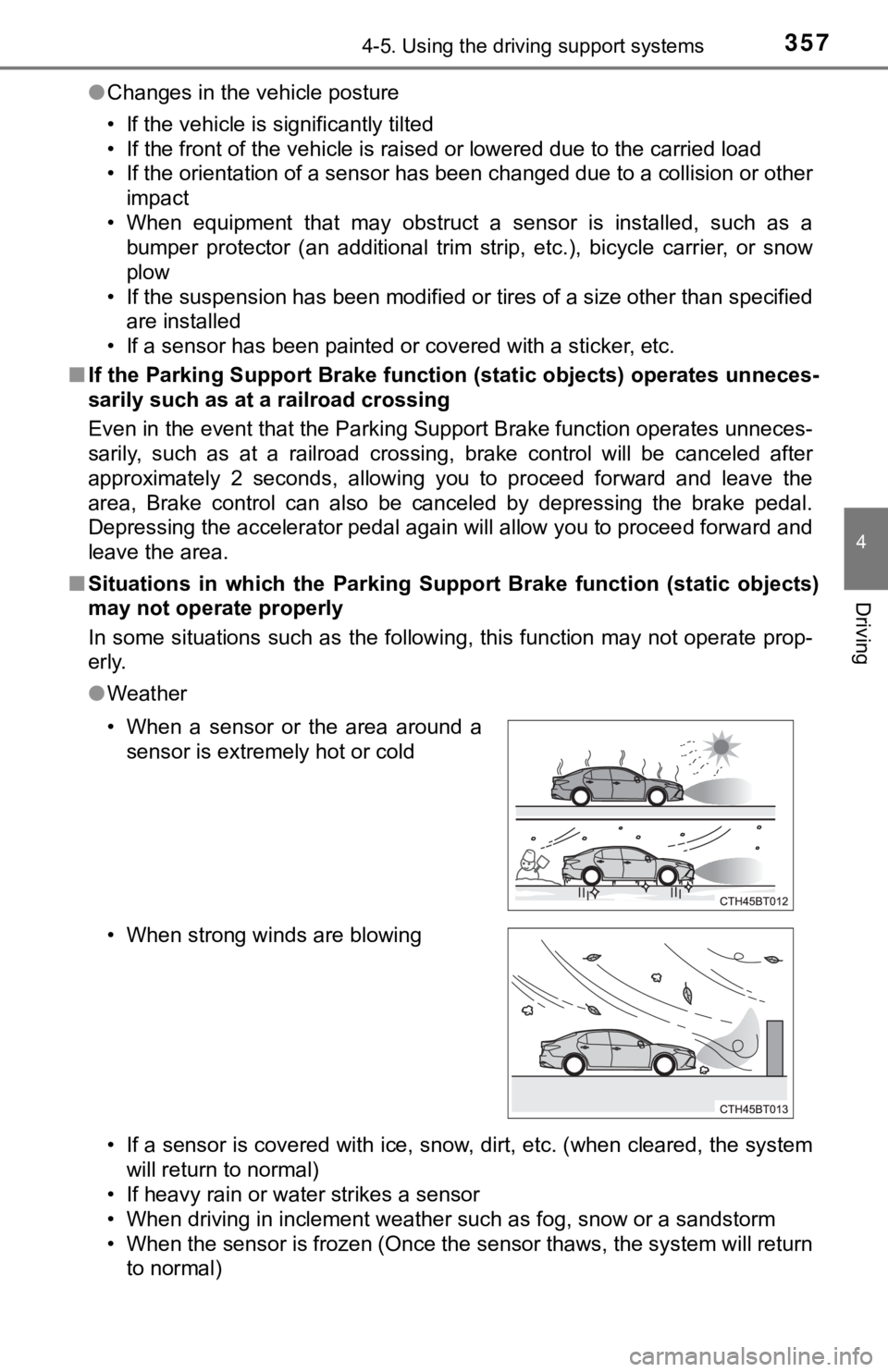TOYOTA CAMRY HYBRID 2021 Owners Manual (in English)
Manufacturer: TOYOTA, Model Year: 2021, Model line: CAMRY HYBRID, Model: TOYOTA CAMRY HYBRID 2021Pages: 624, PDF Size: 15.98 MB
Page 351 of 624

3514-5. Using the driving support systems
4
Driving
WARNING
■Limitations of the Par king Support Brake system
Do not overly rely on the system, as doing so may lead to an accident.
Always drive while checking the safety of the surroundings of the vehicle.
Depending on the vehicle and road conditions, weather, etc., the system
may not operate.
The detection capabilities of sensors and radars are limited. A lways drive
while checking the safety of the surroundings of the vehicle.
● The driver is solely responsible for safe driving. Always drive carefully, tak-
ing care to observe your surroundings. The Parking Support Brake system
is designed to provide support to lessen the severity of collisions. How-
ever, it may not operate in some situations.
● The Parking Support Brake system is not designed to stop the vehicle
completely. Additionally, even if the system has stopped the vehicle, it is
necessary to depress the brake pedal immediately as brake control will be
canceled after approximately 2 seconds.
NOTICE
■If “PKSB Unavailable” is displayed on the multi-information dis play
and the PKSB OFF indicator is flashing
If this message is displayed immediately after the power switch is turned to
ON mode, operate the vehicle carefully, paying attention to your surround-
ings. It may be necessary to drive the vehicle for a certain am ount of time
before the system returns to normal. (If the system is not return to normal
after driving for a while, clean the sensors and their surrounding area on the
bumpers.)
Page 352 of 624

3524-5. Using the driving support systems
The system will operate in situat ions such as the following if an object
is detected in the traveling direction of the vehicle.
■When traveling at a low speed and the brake pedal is not
depressed, or is depressed late
Parking Suppor t Brak e function (static
objects)
: If equipped
If a collision with an object ma y occur due to the vehicle sud-
denly moving forward due to an accidental accelerator pedal
operation, the vehicle moving th e unintended direction due to
the wrong shift position being se lected, or while parking or trav-
eling at low speeds, the sensors detect objects, such as a wall ,
in the traveling direction of t he vehicle, and the system opera tes
to lessen an impact with an object and reduce the resulting dam -
age.
Examples of system operation
Page 353 of 624

3534-5. Using the driving support systems
4
Driving
■When the accelerator pedal is depressed excessively
■When the vehicle moves in the unintended direction due to the
wrong shift position being selected
Page 354 of 624

3544-5. Using the driving support systems
■The Parking Support Brake function (static objects) will operate when
The function will operate when the PKSB OFF indicator is not illuminated or
flashing ( P. 346, 350) and all of the following conditions are met:
● Hybrid system output restriction control
• The Parking Support Brake system is enabled.
• The vehicle speed is approximately 10 mph (15 km/h) or less.
• There is an object in the traveling direction of the vehicle a nd approxi-
mately 6 to 13 ft. (2 to 4 m) away.
• The system determines that a stronger-than-normal brake operat ion is
necessary to avoid a collision.
● Brake control
• Hybrid system output restriction control is operating.
• The system determines that an emergency brake operation is nec essary
to avoid a collision.
■ The Parking Support B rake function (static objects) will stop o perating
when
The function will stop operating if any of the following condit ions are met:
● Hybrid system output restriction control
• The Parking Support Brake system is disabled.
• The collision becomes avoidable with normal brake operation.
• The object is no longer approximately 6 to 13 ft. (2 to 4 m) a way in the
traveling direction of the vehicle.
● Brake control
• The Parking Support Brake system is disabled.
• Approximately 2 seconds elapse after the vehicle is stopped by brake
control.
• The brake pedal is depressed after the vehicle is stopped by b rake con-
trol.
• The object is no longer approximately 6 to 13 ft. (2 to 4 m) a way in the
traveling direction of the vehicle.
■ Detection range of the Parking Support Brake function (static objects)
The detection range of the Parking Support Brake function diffe rs from the
detection range of the intuitive parking assist. ( P. 330)
Therefore, even if the intuitive parking assist detects an obje ct and provides a
warning, the Parking Support Brake function may not start opera ting.
Page 355 of 624

3554-5. Using the driving support systems
4
Driving
■Re-enabling the Parkin g Support Brake system
P. 350
■ Objects that the Parking Support Brake func tion (static objects) may not
detect
The sensors may not be able to detect certain objects, such as the following.
● Pedestrian
● Cotton cloth, snow, and other materials that are poor reflector s of ultrasonic
waves.
(People may also not be detected depending on the type of cloth ing they are
wearing.)
● Objects which are not perpendicular to the ground, are not perp endicular to
the traveling direction of the vehicle, are uneven or are wavin g.
● Low objects
● Thin objects such as wires, fences, ropes and signposts
● Objects that are extremely close to the bumper
● Sharply-angled objects
● Tall objects with upper sections projecting outwards in the dir ection of your
vehicle
■ Situations in which the Parking S upport Brake may not operate properly
When the shift lever is in N
■ Intuitive parking assist buzzer
Regardless of whether the intuitive parking assist system is en abled or not
( P. 327), if the Parking Support Brake system is enabled ( P. 346), the
front or rear sensors detect an object and brake control is performed, the intu-
itive parking assist buzzer will sound to notify the driver of the approximate
distance to the object.
Page 356 of 624

3564-5. Using the driving support systems
■Situations in which the Parkin g Support Brake function (static objects)
may operate even if there is no possibility of a collision
In some situations such as the following, the Parking Support B rake function
may operate even though there is no possibility of a collision.
● Vehicle surroundings
• When driving toward a banner, flag, low-hanging branch or boom barrier
(such as those used at railroad crossings, toll gates and parki ng lots).
• When driving on a narrow path surrounded by a structure, such as in a
tunnel or on an iron bridge
• When parallel parking
• When there is a rut or hole in the surface of the road
• When driving on a metal cover (grating), such as those used fo r drainage
ditches
• When driving on a steep slope
• If a sensor is hit by a large amount of water, such as when driving on a flooded road
● Weather
• If a sensor is covered with ice, snow, dirt, etc. (when cleared, the system
will return to normal)
• If heavy rain or water strikes a sensor
• When driving in inclement weather such as fog, snow or a sands torm
• When strong winds are blowing
● Other ultrasonic waves sources
• When vehicle horns, vehicle detectors, motorcycle engines, air brakes of
large vehicles, the clearance sonar of other vehicles or other devices
which produce ultrasonic waves are near the vehicle
• If a sticker or an electronic component, such as a backlit license plate (especially fluorescent type), fog lights, a fender pole or wir eless antenna
is installed near a sensor
• When driving on a narrow road
• When driving on a gravel road or in
an area with tall grass
Page 357 of 624

3574-5. Using the driving support systems
4
Driving
●Changes in the vehicle posture
• If the vehicle is significantly tilted
• If the front of the vehicle is raised or lowered due to the ca rried load
• If the orientation of a sensor has been changed due to a collision or other impact
• When equipment that may obstruct a sensor is installed, such a s a
bumper protector (an additional trim strip, etc.), bicycle carr ier, or snow
plow
• If the suspension has been modified or tires of a size other than specified are installed
• If a sensor has been painted or covered with a sticker, etc.
■ If the Parking Support Brake func tion (static objects) operates unneces-
sarily such as at a railroad crossing
Even in the event that the Parking Support Brake function opera tes unneces-
sarily, such as at a railroad crossing, brake control will be c anceled after
approximately 2 seconds, allowing you to proceed forward and leave the
area, Brake control can also be canceled by depressing the brak e pedal.
Depressing the accelerator pedal again will allow you to procee d forward and
leave the area.
■ Situations in which the Parkin g Support Brake function (static objects)
may not operate properly
In some situations such as the following, this function may not operate prop-
erly.
● Weather
• If a sensor is covered with ice, snow, dirt, etc. (when cleared, the system
will return to normal)
• If heavy rain or water strikes a sensor
• When driving in inclement weather such as fog, snow or a sands torm
• When the sensor is frozen (Once the sensor thaws, the system w ill return
to normal)
• When a sensor or the area around a
sensor is extremely hot or cold
• When strong winds are blowing
Page 358 of 624

3584-5. Using the driving support systems
●Vehicle surroundings
• When an object that cannot be detected is between the vehicle and a
detected object
• If an object such as a vehicle, motorcycle, bicycle or pedestrian cuts in front of the vehicle or runs out from the side of the vehicle.
• The vehicle is approaching a tall or curved curb.
• On an extremely bumpy road, on an incline, on gravel, or on gr ass.
• If objects draw too close to the sensor.
● Other ultrasonic waves sources
• When vehicle horns, vehicle detectors, motorcycle engines, air brakes of
large vehicles, the clearance sonar of other vehicles or other devices
which produce ultrasonic waves are near the vehicle
• If a sticker or an electronic component, such as a backlit license plate (especially fluorescent type), fog lights, a fender pole or wir eless antenna
is installed near a sensor
● Changes in the vehicle posture
• If the vehicle is significantly tilted
• If the front of the vehicle is raised or lowered due to the ca rried load
• If the orientation of a sensor has been changed due to a collision or other
impact
• When equipment that may obstruct a sensor is installed, such a s a
bumper protector (an additional trim strip, etc.), bicycle carr ier, or snow
plow
• If the suspension has been modified or tires of a size other than specified are installed
• If a sensor has been painted or covered with a sticker, etc.
Page 359 of 624

3594-5. Using the driving support systems
4
Driving
WARNING
■To ensure the Parking Support Brake can operate properly
Observe the following precautions regarding the sensors ( P. 346). Failure
to do so may cause a sensor to not operate properly, and may cause an
accident.
● Do not modify, disassemble or paint the sensors.
● Do not replace a sensor with a part other than a genuine part.
● Do not subject a sensor or its surrounding area to a strong impact.
● Do not damage the sensors, and always keep them clean.
● If the area around a sensor is subjected to an impact, the system may not
operate properly due to the sensor being misaligned. Have the vehicle
inspected by your Toyota dealer.
■ Handling the suspension
Do not modify the suspension, as changes to the height or inclination of the
vehicle may prevent the sensors from detecting objects correctly or cause
the system to not operate or operate unnecessarily.
■ If the Parking Support Brake function (static objects) operates unnec-
essarily, such as at a railroad crossing
In the event that the Parking Support Brake function (static ob jects) oper-
ates unnecessarily, such as at a railroad crossing, brake contr ol will be can-
celed after approximately 2 seconds, allowing you to proceed forward and
leave the area, brake control can also be canceled by depressing the brake
pedal. Depressing the accelerator pedal after brake control is canceled will
allow you to proceed forward and leave the area.
Page 360 of 624

3604-5. Using the driving support systems
NOTICE
■Notes when washing the vehicle
Do not apply intensive bursts of water or steam to the sensor a rea.
Doing so may result in the sensor malfunctioning.
● When using a high pressure washer to wash the vehicle, do not spray the
sensors directly, as doing so may cause a sensor to malfunction .
● When using steam to clean the vehicle, do not direct steam too close to
the sensors as doing so may cause a sensor to malfunction.
■ When to disable the Parking Support Brake
In the following situations, disable the Parking Support Brake as the system
may operate even though there is no possibility of a collision.
● When inspecting the vehicle using a chassis roller, chassis dynamo or free
roller
● When loading the vehicle onto a boat, truck or other transport vessel
● If the suspension has been modified or tires of a size other than specified
are installed
● If the front of the vehicle is raised or lowered due to the carried load
● When equipment that may obstruct a sensor is installed, such as a towing
eyelet, bumper protector (an additional trim strip, etc.), bicycle carrier, or
snow plow
● When using an automatic car wash